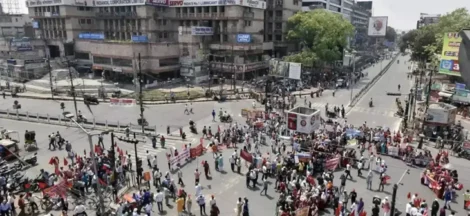By Krishna Jha
We are living in a time zone when our children, hardly within three months time, learn to live without anything, solid or liquid. They consume their own strength as nourishment and manage to survive. Who will own up the crime? Perhaps it is a living reproach to the entire civilisation.
Our days are swallowed by famine like situation. With unusual rise in prices, and absence of employment, life itself has become an unbearable reality as the growing rate of suicides among the unemployed youth shows. Rate of unemployment has been touching the roof and deflation appears to be our future. It is the first time after the great depression when unemployment stares directly into our eyes.
The promises made in the election campaigns satisfy only those making the colourful poll rhetoric to impress the masses, they do not quench the hunger eating up the entire generation. Strangely enough, our country’s economic progress has been assessed at robust 8.4 per cent GDP growth in the first three months in 2023-2024. It defeated even the most optimistic review of the situation. In the aftermath, questions were raised. Reality was soon unveiled in a study of youth by Lokniti CSDS survey and the missing point was discovered.
Almost eighty percent had reported that jobs were either impossible or difficult to have. If the growth has been declared, it has no link with job growth as well. Those at the prime of their life, and capable to offer their best constitute 63 percent of our population. It is crucial to have these sections engaged in production. Economic growth would never be possible if jobless growth continues. The present establishment is keen to make us believe that youth should dream of being job creators, instead of becoming job seekers.
The initiative is to promote entrepreneurship. But in the prevailing situation, the general masses do not have the necessary means to opt for it. Here the question arises about who would shoulder the responsibility to create the opportunity to give work, and the choice goes to either the government or the entrepreneurs. Both the options have dimensions of their own, in deciding the character of economic growth and also about the resources. That is why majority of Indians consider the government at the Centre responsible for the grim situation. It is clear that the respondents realise where they should look for the factors leading to the catastrophe.
The data also shows that at least one in every six respondents considers the Central government responsible for the tragic situation. For them government has totally failed in reigning the situation. No employment opportunities have come their way, not to talk of its adequacy. So far as voting preferences are concerned, the issue of unemployment overshadows the options. Inflation or other considerations are pushed to the back seat.
It must be noted here that India’s urban employment has fallen to 6.5 percent in the fourth quarter of 2023. It is lowest since June, 2018. According to ILO report, the young men in the country, especially if they are educated, they are more likely to be jobless. According to the survey done by the LocalCircles Service, insights have been provided about the dark patterns emerging on the economy.ILO report also highlights the joblessness among the graduated youth at 29.1 percent which is almost nine times than the 3.4 percent unemployment rate for individuals who are illiterate
Furthermore, young people possessing secondary or higher education faced an unemployment rate six times higher at 18.4 percent. In our country the highly educated young people are more likely to be unemployed than those without any schooling, as ILO stated. Drawing on the latest official data, report highlights recent trends in the Indian labour market which indicate so called improvement in some outcomes along with Covid -19 Pandemic. Along with labour force participation rate, especially for women and the unemployment rate had experienced some progress post 2019,due to an agricultural employment increase in the rural areas. A novel employment condition index applied across the states in the country reveals a positive trend over the last decade, but the reality is that it was negatively impacted by the Centre’s policy framework.
As far as demographic dividend is concerned, there is a greater number of educated youth suffering from absence of job creation for them. There is also the dire need for improving job quality. Addressing labour market inequalities is also imperative for economic health in the country. There is also the urgent need for strengthening skills and formulate active labour market policies, and also bridging gap between knowledge deficits on labour market pattern.
The Labour Force Participation Rate (LFPR), Worker Population Ratio (WPR) and Unemployment Rate (UR) showed a long term deterioration till 2018, but later there was noticeable improvement, according to the study. It also pointed out that improvement came with periodic distress. The authors of the report cautioned that the improvement has to be studied carefully as the employment generated by the drivers had their own contradictions. Migration of rural to urban areas by the agricultural workers was one factor that took its toll in this shift. It was in fact a general phenomenon and natural in the development process. The reason for this shift was lure for better wages, employment opportunities, in industries and services as the graph of urbanisation was going up.
In a market economy like India, the movement of people for better opportunities is inevitable. The food grain production kept up its high levels. If this is so, then why is it that people are not getting enough food. Even the agriculture sector is facing a threat. As per the seventh schedule of our Constitution, land comes under the purview of state government, and therefore it is on the state governments, and the Centre has to help the states through supplementing in crop development programmes. But in reality, the Centre is busy in acquiring land for its own vested interests. The land in their hands turns into capital. (IPA Service)



